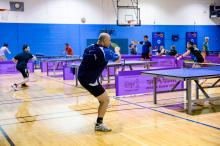Typically, playing about 60-65% forehand and about 35-40% backhand will allow you to cover the table best. However, for some of my students, I give some flexibility as each player/style/age/conditioning/body type is unique. Because the forehand zone is larger, most players practice forehand footwork or full-table footwork. I have rarely seen players practicing backhand footwork.
Before I give you a list of backhand footwork drills that I personally do, I must first explain the difference between the backhand hitting zone and the forehand hitting zone. The forehand hitting zone is much taller, wider, and deeper. With the possibility of reaching slightly and up or down our out or leaning in, your stroke is taller and wider. With the possibility of hitting the forehand slightly behind, beside, or in-front of your body, the forehand hitting zone is also deeper. The same is not true with the backhand. The backhand hitting zone is short, narrow, and shallow. With the primary snap coming from the wrist and forearm, you lose about 80% of your speed, spin, and control when reaching or leaning. The depth is also more sensitive because your body is in the way; so hitting beside or behind your body is nearly impossible. With a smaller hitting zone on the backhand, I think that you now can understand why backhand footwork is important! It is critically important to expand the hitting zone. That powerful backhand rip that you have is only possible in your zone. Top players won’t often hit to your zone. So you need to move your zone to the ball instead of waiting for the ball to hit your zone! (read the last sentence again and think about it)
Here are a few backhand footwork drills that I love…
Drill #1 (beginner level)
The blocker gives you one ball to the middle and one ball to the backhand; you continuously attack to the backhand. This drill will help you establish the base movement. Position your body about two feet from the table. Stay slightly on your toes and slightly on the inside of your feet. By keeping your racket in-front, your body weight should be leaning forward. As soon as you attack the first ball, shuffle into position for the next hit. Target hitting ten balls each rally, that’s a good goal. If you are consistently make ten shots, then increase the speed slightly.
Drill #2 (intermediate level)
The blocker gives you very slow blocks to the backhand 50% of the table. You continuously attack to the backhand. Focus on watching your opponent’s racket so that you can predict where the incoming ball will likely hit. As the ball approaches, watch the incoming ball until you make contact. If you move correctly and the ball is in your hitting zone, then hit with moderate power. If you did not get in the correct position, then hit with less power. The drill is excellent for developing your ability to watch, your ability to move, and most importantly your ability to adjust your power based on your zone. In matches, you need to decide (within a split second) if you should go strong or if you should just play control. Your ability to make that critical choice, will be the difference this year in winning and losing.
Drill #3 (Advanced Level)
The blocker gives you variation blocks to the backhand 60% of the table – sometimes he blocks very soft and sometimes he applies a bit of pressure. You continuously attack one ball to the backhand and one ball to his forehand. This one is tough! The reason that this drill is so difficult is because you must adjust to various speeds of the block, you must hit to various locations, and you must adjust to balls coming from various locations to the backhand 50% of the table. For this drill, target hitting 7-8 balls each rally. If you are missing before 7-8 balls, then ask the blocker to go slower until you get the hang of it.
Drill #4 (Advanced Level)
The blocker serves short to your forehand. You step forward, lean over the table, and backhand banana flip to his backhand. He blocks quickly to either corner, then the drill turns into a free point, where both players can hit to any location. I see that many players are trying to develop the backhand banana flip; it really is a good shot. As a deterrent for this, many opponents are now serving to the short forehand. Backhand flipping this serve is great, but only if you have backhand footwork and are able to move for the next shot.
Drill #5 (Kids, This Is For Professionals, Don’t Try This At Home)
The blocker serves backspin long to the backhand or short backspin to the forehand. If the blocker serves long, then the drill begins immediately. If the blocker serve short to the forehand, then he can push up to five more times short to the forehand before pushing sharp to the backhand. Now that the drill has started, you attack deep to the blocker’s backhand continuously for 2-10 attacks. When you choose to attack down-the-line, then the blocker counterloops crosscourt and the drill turns into a free point with both players hitting anywhere.
As you can see, backhand footwork is important. By watching your opponent, adjusting with your feet, adjusting your racket, and making good decisions, you will be well on your way to a stronger backhand this year. As with any skill, it takes time. Continuously practicing these skills again and again, and trying them out in matches again and again, will lead to success. Best wishes with your backhand footwork!!!!




